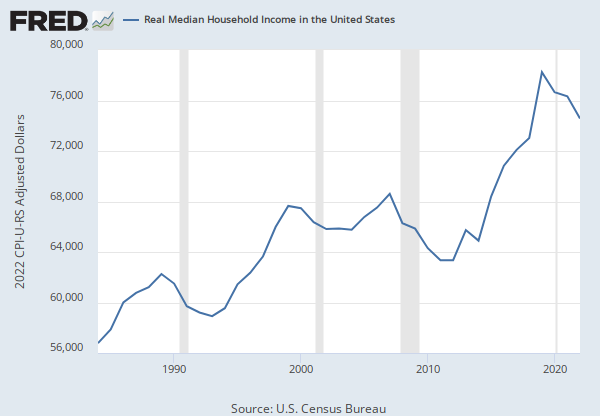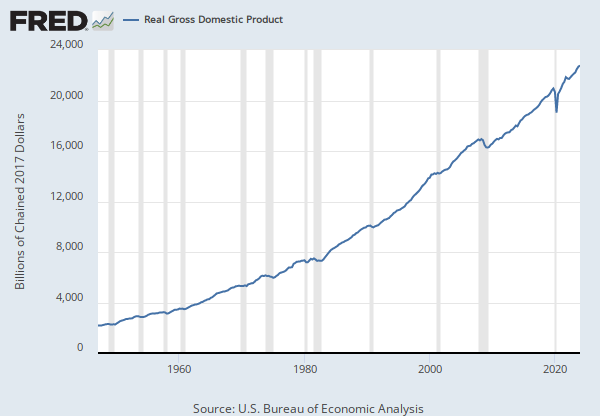FRED Graph
Write a custom formula to transform one or more series or combine two or more series.
You can begin by adding a series to combine with your existing series.
Now create a custom formula to combine or transform the series.
Need help?
For example, invert an exchange rate by using formula 1/a, where “a” refers to the first FRED data series added to this line. Or calculate the spread between 2 interest rates, a and b, by using the formula a - b.
Use the assigned data series variables (a, b, c, etc.) together with operators (+, -, *, /, ^, etc.), parentheses and constants (1, 1.5, 2, etc.) to create your own formula (e.g., 1/a, a-b, (a+b)/2, (a/(a+b+c))*100). As noted above, you may add other data series to this line before entering a formula.
Finally, you can change the units of your new series.
Add the minimum, maximum, and average calculations of selected lines to the graph
Write a custom formula to transform one or more series or combine two or more series.
You can begin by adding a series to combine with your existing series.
Now create a custom formula to combine or transform the series.
Need help?
For example, invert an exchange rate by using formula 1/a, where “a” refers to the first FRED data series added to this line. Or calculate the spread between 2 interest rates, a and b, by using the formula a - b.
Use the assigned data series variables (a, b, c, etc.) together with operators (+, -, *, /, ^, etc.), parentheses and constants (1, 1.5, 2, etc.) to create your own formula (e.g., 1/a, a-b, (a+b)/2, (a/(a+b+c))*100). As noted above, you may add other data series to this line before entering a formula.
Finally, you can change the units of your new series.
Add the minimum, maximum, and average calculations of selected lines to the graph
Data in this graph are copyrighted. Please review the copyright information in the series notes before sharing.
Notes
Source: National Bureau of Economic Research
Release: NBER Macrohistory Database
Units: Billions of Dollars, Seasonally Adjusted
Frequency: Quarterly
Notes:
Series Is Presented Here As Three Variables--(1)--Seasonally Adjusted Data, 1921-1941 (2)--Original Data, 1929-1945 (3)--Seasonally Adjusted Data, 1946-1970. Source: Data Is Direct From Barger And Klein Files, U.S. Department Of Commerce
This NBER data series q08168a appears on the NBER website in Chapter 8 at http://www.nber.org/databases/macrohistory/contents/chapter08.html.
NBER Indicator: q08168a
Suggested Citation:
National Bureau of Economic Research, Personal Income for United States [Q0868AUSQ027SNBR], retrieved from FRED, Federal Reserve Bank of St. Louis; https://fred.stlouisfed.org/series/Q0868AUSQ027SNBR, April 11, 2025.
Source: National Bureau of Economic Research
Release: NBER Macrohistory Database
Units: Millions of Dollars, Not Seasonally Adjusted
Frequency: Annual
Notes:
Social Securities Paid By Employers Are Not Included; Pensions, Compensation For Injury And Relief Payments Are Likewise Excluded From This Series. Source: For 1919-1938: Simon Kuznets, National Income And Its Composition (1941) Volume I, Table 62, Pp.332-323; For 1939: The Data Were Extrapolated With The Aid Of The Department Of Commerce Data From Table 15 Of "National Income And National Product In 1943" By Milton Gilbert And George Jaszi; And Survey Of Current Business, April 1944, P.15.
This NBER data series a08181 appears on the NBER website in Chapter 8 at http://www.nber.org/databases/macrohistory/contents/chapter08.html.
NBER Indicator: a08181
Suggested Citation:
National Bureau of Economic Research, Wages and Salaries, Total for United States [A08181USA144NNBR], retrieved from FRED, Federal Reserve Bank of St. Louis; https://fred.stlouisfed.org/series/A08181USA144NNBR, April 11, 2025.
Source: U.S. Bureau of Economic Analysis
Release: Gross Domestic Product
Units: Billions of Dollars, Not Seasonally Adjusted
Frequency: Annual
Notes:
BEA Account Code: BA06RC
For more information about this series, please see http://www.bea.gov/national/.
Suggested Citation:
U.S. Bureau of Economic Analysis, Total wages and salaries, BLS [BA06RC1A027NBEA], retrieved from FRED, Federal Reserve Bank of St. Louis; https://fred.stlouisfed.org/series/BA06RC1A027NBEA, April 11, 2025.
Source: U.S. Bureau of Economic Analysis
Release: Gross Domestic Product
Units: Billions of Dollars, Not Seasonally Adjusted
Frequency: Annual
Notes:
BEA Account Code: A065RC
Personal income is the income that persons receive in return for their provision of labor, land, and capital used in current production and the net current transfer payments that they receive from business and from government.25 Personal income is equal to national income minus corporate profits with inventory valuation and capital consumption adjustments, taxes on production and imports less subsidies, contributions for government social insurance, net interest and miscellaneous payments on assets, business current transfer payments (net), current surplus of government enterprises, and wage accruals less disbursements, plus personal income receipts on assets and personal current transfer receipts.For more information about this series, please see http://www.bea.gov/national/.
Suggested Citation:
U.S. Bureau of Economic Analysis, Personal income [A065RC1A027NBEA], retrieved from FRED, Federal Reserve Bank of St. Louis; https://fred.stlouisfed.org/series/A065RC1A027NBEA, April 11, 2025.
Related Data and Content
Data Suggestions Based On Your Search
Content Suggestions
Other Formats
Related Categories
Releases
Tags
Permalink/Embed
modal open, choose link customization options
Select automatic updates to the data or a static time frame. All data are subject to revision.
































